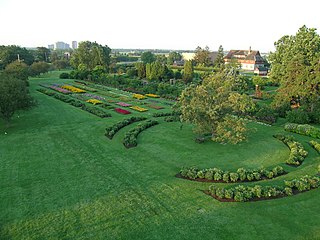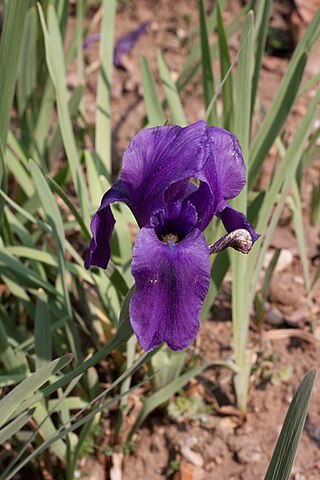
Geranium is a genus of 422 species of annual, biennial, and perennial plants that are commonly known as geraniums or cranesbills. They are found throughout the temperate regions of the world and the mountains of the tropics, with the greatest diversity in the eastern part of the Mediterranean region.

Geranium cinereum, the ashy cranesbill, is a species of flowering plant in the family Geraniaceae, native to the Pyrenees. Growing to 50 cm (20 in) tall and wide, it is a small, deciduous or semi-evergreen perennial usually grown for low ground cover, rockeries or underplanting larger subjects like roses. Leaves are deeply divided and grey-green – whence the Latin specific epithet cinereum "ash-grey". It flowers in summer, with striking black-eyed flowers with black stamens. The plant grows in full sunlight, and is hardy down to −15 °C (5 °F).

Geranium × magnificum, the purple cranesbill, is a species of hardy flowering herbaceous perennial plant in the genus Geranium, family Geraniaceae. The multiplication symbol × indicates that it is the result of hybridisation, in this case between Geranium platypetalum and Geranium ibericum. Growing into a clump 70 cm (28 in) high and broad, it has the decorative, deeply-lobed leaves typical of the genus Geranium. Violet-blue flowers with darker veins are borne relatively briefly in early summer. Extremely hardy, to below −20 °C (−4 °F), it is suitable for cultivation throughout all temperate regions. This plant has gained the Royal Horticultural Society's Award of Garden Merit.

The peony or paeony is any flowering plant in the genus Paeonia, the only genus in the family Paeoniaceae. Peonies are native to Asia, Europe, and Western North America. Scientists differ on the number of species that can be distinguished, ranging from 25 to 40, although the current consensus describes 33 known species. The relationships between the species need to be further clarified.

Alstroemeria, commonly called the Peruvian lily or lily of the Incas, is a genus of flowering plants in the family Alstroemeriaceae. They are all native to South America, although some have become naturalized in the United States, Mexico, Australia, New Zealand, Madeira and the Canary Islands. Almost all of the species are restricted to one of two distinct centers of diversity; one in central Chile, the other in eastern Brazil. Species of Alstroemeria from Chile are winter-growing plants, while those of Brazil are summer growing. All are long-lived perennials except A. graminea, a diminutive annual from the Atacama Desert of Chile.

Graham Stuart Thomas was an English horticulturist, who is likely best known for his work with garden roses, his restoration and stewardship of over 100 National Trust gardens and for writing 19 books on gardening, many of which remain classics today. However, as he states in the Preface to his outstanding book, The Rock Garden and its Plants: From Grotto to Alpine House, "My earliest enthusiasms in gardening were for....alpines." p8

Hibiscus moscheutos, the rose mallow, swamp rose-mallow, crimsoneyed rosemallow, or eastern rosemallow, is a species of flowering plant in the family Malvaceae. It is a cold-hardy perennial wetland plant that can grow in large colonies. The hirsute leaves are of variable morphology, but are commonly deltoidal in shape with up to three lobes. It is found in wetlands and along the riverine systems of the eastern United States from Texas to the Atlantic states, its territory extending northward to southern Ontario.

Geranium maculatum, the wild geranium, spotted geranium, or wood geranium, is a perennial plant native to woodland in eastern North America, from southern Manitoba and southwestern Quebec south to Alabama and Georgia and west to Oklahoma and South Dakota.

The Sir Harold Hillier Gardens is an arboretum comprising 72 hectares accommodating over 42,000 trees and shrubs in about 12,000 taxa, notably a collection of oaks, camellia, magnolia and rhododendron.

Geranium sylvaticum, the wood cranesbill or woodland geranium, is a species of hardy flowering plant in the family Geraniaceae, native to Europe and northern Turkey.

The Ornamental Gardens are an agricultural facility that emphasizes research, education, and beauty as part of Agriculture and Agri-Food Canada's Central Experimental Farm. As the name indicates, the gardens are centrally located in and now surrounded by the city of Ottawa, Ontario, Canada. The 8-acre garden is a National Historic Site and Cultural Heritage Landscape.

Musa basjoo, known variously as Japanese banana, Japanese fibre banana or hardy banana, is a species of flowering plant belonging to the banana family Musaceae. It was previously thought to have originated in the Ryukyu islands of southern Japan, from where it was first described in cultivation, but is now known to have originated in subtropical southern China, where it is also widely cultivated, with wild populations found in Sichuan province. Its specific name is derived from its Japanese common name, bashō (芭蕉).

The Hebe Society promotes the cultivation and conservation of hebes and other New Zealand native plants.
The Wildflower Society of Western Australia (Inc.) (WSWA) is a member of the Australian Native Plants Society (Australia). In each of the other states of Australia, there is a region of the ANPS(A) and they share many of the aims of the WSWA.
Paeonia sterniana is a perennial, herbaceous peony of approximately 45 cm high in cultivation, with white or sometimes pinkish flowers. It grows in the wild in southeastern Tibet. This peony is very rare in cultivation. It produces blue seeds in autumn. Its common name in Chinese is 白花芍药, which means "white peony".

Paeonia tenuifolia is a herbaceous species of peony that is called the steppe peony or the fern leaf peony. It is native to the Caucasus Mountains, with large fields found in Vashlivani National Park in Georgia and the Black Sea coast of Ukraine, spreading westward into Bulgaria, Romania and Serbia and eastward to northwestern Kazakhstan. It was described by Linnaeus in 1759. The leaves are finely divided into almost thread-like segments and grow close together on the stems. This peony can reach 30–60 cm (12–24 in) in height. The scented red flowers have numerous yellow stamens in the centre.

The Alpine Garden Society headquarters are at Pershore, Worcestershire. It is an "International Society for the cultivation, conservation and exploration of alpine and rock garden plants, small hardy herbaceous plants, hardy and half-hardy bulbs, hardy ferns and small shrubs".

Geranium renardii is a species of hardy flowering herbaceous perennial plant in the genus Geranium, in the family Geraniaceae. It is native to the Caucasus region between Europe and Asia. Growing to 30 cm (12 in) tall and broad, it has palmate leaves and pale pink flowers striped violet. This plant has gained the Royal Horticultural Society's Award of Garden Merit. It grows well in sunny positions or shade both and well drained soils.
The North American Native Plant Society (NANPS) is a volunteer-operated, registered charitable organization concerned with conserving native plants in wild areas and restoring indigenous flora to developed areas. It is noted for its work in educating business and the public about the benefits of using native plants, and its work in promoting native species through plant sales and seed exchanges has been credited with the resurgence of some species. It also maintains a list of local native plant societies across the United States and Canada.

Iris hoogiana is a plant species in the genus Iris, it is also in the subgenus Iris and in the section Regelia. It is a rhizomatous perennial, from the grassy mountainsides of Turkestan. It has long green leaves, which are slightly purple at the base, and a long slender flowering stem. The flowers are blue, ranging from sky-blue to lavender blue and blue purple. It has orange or yellow beards. It is cultivated as an ornamental plant in temperate regions.
















